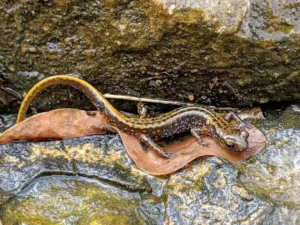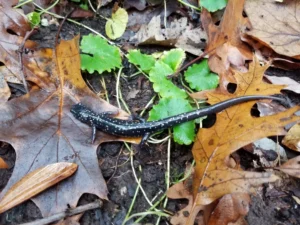Salamanders are quiet animals that usually stay out of sight, even when they are close by. Many people never notice them unless they already know where to look. Their colors help them blend in, and their habits keep them hidden. This leads to a common question: where do salamanders actually hide?
Salamanders hide in cool, damp places like under rocks, logs, leaves, and in holes or cracks. These spots help them stay moist and safe from danger.
Because they breathe partly through their skin, they must stay wet to stay alive. They also try not to be seen, so they use whatever cover they can find.
Why Salamanders Need to Stay Hidden
Salamanders have soft skin that water can pass through. This skin helps them breathe, but it also dries out fast. Unlike people, who have thick skin that keeps water in, salamanders need to stay wet so they can take in oxygen.

This makes sun and wind dangerous. Even when it’s cloudy, dry air can harm them. Hiding in damp, shaded spots helps keep their skin from drying. These hiding places also stay cool, which slows down water loss.
They also hide to avoid predators. Many animals eat salamanders, such as birds, snakes, raccoons, and fish. Because salamanders are small and slow, they are easy to catch. Staying hidden helps them stay safe.
Common Places Salamanders Use for Shelter
Salamanders live in many places, but they often choose the same kinds of hiding spots. These spots have three things in common: they are dark, moist, and quiet.
Here are some of the most common hiding places:
1. Under Logs
Fallen logs give both shelter and moisture. The space under a log stays cool and wet, especially in shady woods. Salamanders often curl up in the gaps between the bark and the wood. Some types even lay their eggs there.
Logs also bring insects and worms, which are food for salamanders. So a log can be both a shelter and a place to hunt.
2. Beneath Rocks
Flat rocks on soft ground make great cover. Water collects under them after rain, keeping the soil damp. Salamanders sometimes push the dirt aside to make a small resting spot. This helps them avoid dry air.
Rocks are used more by smaller kinds of salamanders or those that live in soft, wooded areas. In drier, rocky places, they may stay deeper underground instead.
3. Inside Leaf Litter
Dead leaves on the ground form a thick, soft layer that stays damp most of the year. Salamanders move through this layer to feed and hide. Some spend their whole lives just under the surface and never leave the leaf cover.

This layer also protects eggs. Many salamanders lay their eggs in damp leaf piles near rocks or logs, which keeps them hidden from animals that might eat them.
4. In Burrows
Some salamanders dig their own burrows. Others use tunnels made by insects, worms, or small animals. These underground spaces protect them from heat and cold, and help them stay moist.
Burrows are extra helpful in dry places or during times when the surface is too hot or cold. A salamander can wait in a burrow until conditions improve.
5. In Tree Bark and Logs (for Tree-Dwelling Species)
Some salamanders, like the arboreal salamander, live in trees. They hide in cracks in the bark, holes in tree trunks, or damp moss. These places can hold enough moisture to keep their skin from drying.

Tree-dwelling salamanders are not common, but they have special ways of hiding. They often stay still for long periods so they are less likely to be seen.
6. In and Around Water
Salamanders that live in water hide under underwater rocks, inside logs, or in the roots of plants. These places protect them from strong water currents and from animals that might eat them.
Even land salamanders sometimes return to water at certain times, such as during breeding season. They may hide near ponds or in wet grass, where they can stay moist while waiting for rain.
How the Seasons Affect Hiding
The places salamanders hide can change with the season. In cold weather, many go into a resting state similar to hibernation.
They move deep into logs, holes, or soil where temperatures stay more steady. This helps them survive the winter.
In hot, dry months, salamanders in warmer places may also go into hiding. This is called “aestivation,” a kind of rest caused by heat or dryness. They stay in deep burrows or shaded spots until the weather gets better.
In spring and fall, when it’s damp and mild, salamanders may be easier to spot. They come out to look for food or find mates. But even then, they often go back into hiding quickly.
How Salamanders Pick a Good Hiding Spot
Salamanders don’t just hide anywhere. They notice small changes in moisture, light, and temperature. If a log is too dry, they may skip it. If a hole is too shallow or too cold, they look somewhere else.
Some salamanders return to the same hiding place over and over. This might help them find food or avoid danger in spots they already know are safe.

Other things that affect where they hide include:
- Size and species: Bigger salamanders need bigger shelters. Small ones can fit in narrow cracks or leaf piles.
- Local climate: Salamanders in wet forests behave differently from those in dry or rocky places.
- Predators: In areas with more predators, salamanders may hide more often or choose safer, deeper spots.
How Humans Affect Salamander Hiding Places
When people cut down trees, drain streams, or flatten soil, salamanders lose many of their hiding spots. Even moving a few logs or rocks can take away their shelter.
Chemicals like pesticides and pollution can also ruin the damp spots they need. If the ground dries out or the water becomes harmful, salamanders may not survive.
To help salamanders, it’s important to protect their natural cover. Leaving fallen logs, keeping leaf litter on the ground, and not removing rocks can help them find shelter.
Even in gardens or parks, salamanders may use these materials to hide.
Signs a Salamander Might Be Nearby
Salamanders are secretive, but there are small signs that show where they might be hiding:
- Wet trails or prints under rocks
- Small holes in soft, wet soil
- Egg clusters under logs or in leaf piles
- Rustling leaves after it rains
These signs are easier to spot in spring or after a wet night. Salamanders may come out to hunt or mate but usually go back into hiding soon after.
Looking for Salamanders Under Logs or Rocks
In some places, you might find a salamander by gently lifting a rock or log in a wet forest. But this should always be done with care. Too much light or air can dry them out or stress them.
If you do decide to look under a log or stone:
- Pick a cool, damp day
- Lift slowly and try not to disturb the soil
- Watch without touching the salamander
- Put everything back just as you found it
Don’t check the same spot again and again. This can scare salamanders away or harm the small animals and plants they rely on.
Conclusion
Salamanders hide in places that help them stay moist, avoid danger, and handle changes in weather. These places include logs, rocks, leaves, burrows, and tree bark. The hiding spot they choose depends on the species, the season, and the area where they live.
Because they depend on these shelters, salamanders struggle to survive where natural cover is removed.
If you know what to look for, and where to look, you might find a salamander hiding nearby, right under your feet.
Hi, my name is Ezra Mushala, i have been interested animals all my life. I am the main author and editor here at snakeinformer.com.

